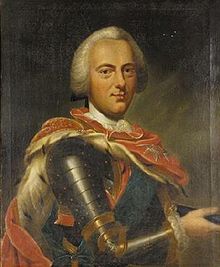Charles I, Duke of Brunswick-Wolfenbüttel
| Charles I | |
|---|---|
 Portrait by Johann Georg Ziesenis | |
| Prince of Brunswick-Wolfenbüttel | |
| Reign | 2 September 1735 – 26 March 1780 |
| Predecessor | Ferdinand Albert II |
| Successor | Charles William Ferdinand |
| Born | 1 August 1713 Brunswick |
| Died | 26 March 1780 (aged 66) Brunswick |
| Spouse | Princess Philippine Charlotte of Prussia |
| Issue | Charles William Ferdinand, Duke of Brunswick Prince Georg Franz Sophie, Margravine of Brandenburg-Bayreuth Prince Christian Ludwig Anna, Duchess of Saxe-Weimar-Eisenach Prince Frederick Augustus Prince Albrecht Heinrich Princess Louise Prince Wilhelm Adolf Elisabeth Christine, Crown Princess of Prussia Princess Friederike Augusta Dorothea, Abbess of Gandersheim Prince Maximilian Julius Leopold |
| House | House of Guelph |
| Father | Ferdinand Albert II, Duke of Brunswick-Wolfenbüttel |
| Mother | Duchess Antoinette of Brunswick-Wolfenbüttel |
Charles (German: Karl; 1 August 1713, Braunschweig – 26 March 1780, Braunschweig), Duke of Brunswick-Lüneburg (Bevern line), reigned as Prince of Brunswick-Wolfenbüttel from 1735 until his death.
Life
[edit]

Charles was the eldest son of Ferdinand Albert II, Duke of Brunswick-Wolfenbüttel. He fought under Prince Eugene of Savoy against the Ottoman Empire before inheriting the Principality of Brunswick-Wolfenbüttel from his father in 1735. Through his mother he was first cousins with Empress Maria Theresa
On the suggestion of his court-preacher, Johann Friedrich Wilhelm Jerusalem, in 1745 he founded the Collegium Carolinum, an institute of higher education which is today known as the Technical University of Brunswick. He also hired Gotthold Ephraim Lessing as the librarian for the Bibliotheca Augusta, the ducal library. Lorenz Heister of the University of Helmstedt named the botanical genus Brunsvigia in his honour, in recognition of his encouragement of botany and the study of B. orientalis.[1]
Charles attempted to promote the economic development of his state; for example, he founded the Fürstenberg Porcelain Company, and he installed mandatory fire insurance. However, he did not manage to keep the state finances in check. As a consequence, in 1773 his eldest son Charles William Ferdinand took over government.
When the American Revolution began in 1775, Prince Charles saw an opportunity to replenish the duchy's treasury by renting its army to Great Britain. In 1776, Duke Charles signed a treaty with his cousin George III of the United Kingdom to supply troops for service with the British armies in America. 4,000 soldiers were dispatched under General Friedrich Adolf Riedesel. The Brunswick troops fought in General John Burgoyne's army at the Battles of Saratoga (1777), where they were taken prisoner as part of the Convention Army. Although the terms of surrender allowed the troops to return to Europe, the American Continental Congress cancelled the convention. The Convention Army was held prisoner in America until the war ended in 1783.[2]
Marriage and children
[edit]In 1733, Charles married Philippine Charlotte, daughter of King Frederick William I of Prussia and sister of Frederick the Great. They had the following children that reached adulthood:
- Charles William Ferdinand (1735–1806), father of Queen Caroline of Brunswick, wife of George IV of Great Britain.
- Sophie Caroline Mary (1737–1817), married Frederick, Margrave of Brandenburg-Bayreuth
- Anna Amalia (1739–1807), married Ernest Augustus II, Duke of Saxe-Weimar-Eisenach
- Frederick Augustus (1740–1805)
- Albert Henry (26 February 1742 – 8 August 1761), died childless
- William Adolf (18 May 1745 – 24 August 1770), died childless
- Elizabeth Christine Ulrike (1746–1840), married King Frederick William II of Prussia (divorced). She was the mother of Frederica, Duchess of York.
- Augusta Dorothea, Abbess of Gandersheim (1749–1803)
- Maximilian Jules Leopold (1752–1785), died childless
Charles also had a child out of wedlock, Christian Theodor (1750–1824), who later took the name de Pencier after his step-father.
Ancestry
[edit]References
[edit]- ^ Snijman, Dee (April 2005). "Brunsvigia". www.plantzafrica.com. South African National Biodiversity Institute. Retrieved 14 April 2016.
The name Brunsvigia was first published in 1755 by Lorenz Heisters (1683-1758), a botanist and professor of medicine at the University of Helmstädt. It honours Karl, the Sovereign of Braunschweig, who promoted the study of plants, including the beautiful Cape species B. orientalis.
- ^ "Friedrich Kaltofen, one of the intentionally misnamed 'Brunswick Deserters.'". Archived from the original on 4 March 2016. Retrieved 9 October 2014.
- ^ Genealogie ascendante jusqu'au quatrieme degre inclusivement de tous les Rois et Princes de maisons souveraines de l'Europe actuellement vivans [Genealogy up to the fourth degree inclusive of all the Kings and Princes of sovereign houses of Europe currently living] (in French). Bourdeaux: Frederic Guillaume Birnstiel. 1768. p. 51.
- At the House of Welf site (in German)
External links
[edit] Media related to Charles I, Duke of Brunswick-Wolfenbüttel at Wikimedia Commons
Media related to Charles I, Duke of Brunswick-Wolfenbüttel at Wikimedia Commons


 French
French Deutsch
Deutsch